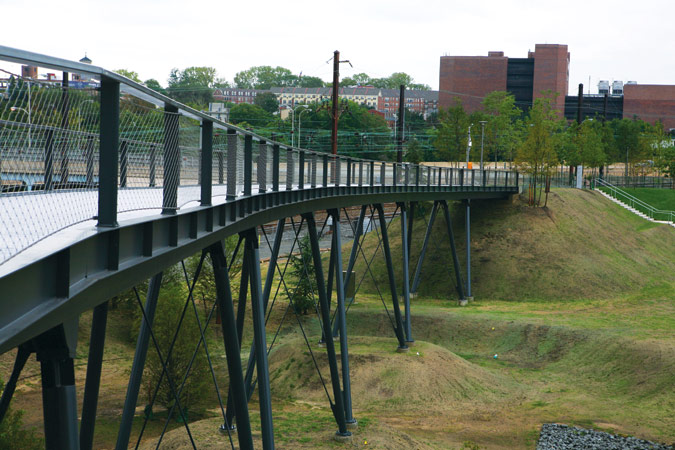
Creating a park atop an abandoned railway presents some challenges, but try designing a 23-acre park between a fully functioning high-speed rail corridor, a commuter train line, a freeway, freight tracks, and two major downtown arteries. “It was one those scrappy pieces of land,” Michael Van Valkenburgh of Michael Van Valkenburgh Associates (MVVA) said of Penn Park’s former self. The landscape architect was commissioned by the University of Pennsylvania to weave the public park together with private Ivy League athletic fields. Comprised of two turf fields, a tennis center, a multipurpose stadium for Penn athletes, plus two large, informal play fields for the public, Penn Park opened on September 15.
|
Left to right: the playing fields; the old elevated CSX Highline; a detail of the stone steps; crossing over rail lines.
|
||||||
In spite of the challenging site, it took only 18 months to complete, though planning goes back decades. As expanding toward the residential sections of West Philadelphia was never an option, the university had its eye on the former parking lot owned by the Post Office since the 1980s. To obtain the parcel, Penn had to buy the WPA-era post office next to the Thirtieth Street Station. The university promptly flipped it, selling it to Brandywine Reality, who in turn leased it to another Federal Agency, the IRS. There were also difficult negotiations with the various rail companies: easements had to be obtained from Amtrak, CSX, and SEPTA.
A mere baseball’s throw from the Skuylkilll River, the completed park provides unmatched skyline views—to say nothing of finally-realized links to downtown. “It’s very much about the connections,” said Anne Papageorge, Penn’s vice president of facilities and real estate. “We needed to bridge these chasms and voids,” she added. Papageorge knows a bit about bridging chasms, she came to Penn in 2006 from the Lower Manhattan Development Corporation where she was the design director of the 9/11 Memorial.
With the grade change between the park and the street level at thirty feet, and a directive from Penn president Amy Gutmann to connect the downtown to the campus, Van Valkenburgh responded with large land formations that swoop up toward two bridges (engineered by ARUP), one to the north near the city at Walnut Street and the other to the west leading to the campus at Smith Walk. The connections form a giant arc that gently flows down into the park and back up to street level. The public will have unfettered access to the park from street level at both bridges.
|
The 23-acre park slides beneath a CSX freight Highline (left) and the Paley Bridge to the Penn Campus (right).
|
||
Of the $46.5 million spent on the project, about $12 million of it is under ground. The site sits on a flood plane composed of urban fill, a very soft material. Cisterns beneath the playing fields can hold up to 300,000 gallons of rainwater runoff. “Think of it as a sponge, whenever you put something on it with weight, it’ll settle,” said project manager Martin Roura. As a result, continuous bridges down to the park’s grade would’ve been too heavy. The landforms allow each bridge to have just four or five points of contact. Nearly 3,200 pilings support the forms. The tightly patterned concrete columns are topped off with two-foot wide stone pillows that transfer the weight into the landforms. These are covered with about four feet of soil. “It’s like a layer cake that gets soil as frosting,” said Roura.
The campus is notable for its unrestricted access to more than a century of great American architecture from Frank Furness to Louis Kahn. With its fluid connection to the park, the contrast of Van Valkenburgh’s unabashed embrace of hardcore infrastructure with the formalities of the Ivy League campus might strike some as an uneasy marriage. University architect David Hollenberg doesn’t think so. “We don’t have a set of design guidelines; we have a design attitude,” he said. “It’s liberating, but it’s also terrifying. What ties it all-together is the open space, and that whole thing explodes at Penn Park.”